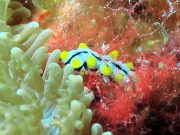Diving with Holothuriidae Sea Cucumbers
Lanta Marine Life | Holothuriidae
The Holothuriidae family of approximately 185 sea cucumbers, several of which we can find in abundance when diving from Koh Lanta.
Holothuriidae sea cucumbers have thick fleshy bodies, ranging from small to very large, often covered with small rounded projections known as papillae. All species have many tube-like feet on the lower body and several species have 15 - 30 oral tentacles.
When stressed or attacked, many members of this family are able to eject many fine sticky white threads from their anus, known as Cuvierian Tubules. These tubes can entangle and disable a predator. The tubes can be internally detached and then re-grown within 2 - 4 weeks.
Depending on the species, sea cucumbers may be concealed below rocks and rubble, buried in sand, found Iying exposed, or in some cases actively moving around a coral reef with their rows of sticky tube feet. A few species are active during the day, however most are active at night.
4 species found on this page:
Elephant trunkfish
(Holothuria fuscopunctata)
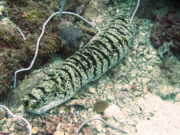
Holothuria fuscopunctata @ Koh Haa
The Elephant trunkfish is a large sea cucumber with a thick body wall, generally golden-brown with dark spots and dark brown wrinkles along its entire body length.
The underside is whitish, the mouth being surrounded by twenty thick brown tentacles and the anus surrounded by a black band.
This sea cucumber can reach up to 70 cm and can weigh up to 4.5kg, though it’s spotted around Lanta more commonly in the 30 - 50 cm range.
This species is normally found down to 30 m, is slow to mature and has a low fertility rate.
Graeffe's Sea Cucumber
(Pearsonothuria graeffei)
The Graeffe's Sea Cucumber is one of the most common sea cucumbers encountered at the dive sites around Koh Lanta. This species of sea cucumber has a white body, with many light, thorny projections surrounded by pale brown blotches. There are many small dark spots all over the body and hundreds of small tube feet on the lower body.
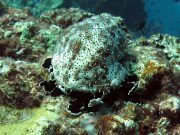
Adult Pearsonothuria graeffei @ Koh Haa
Around the mouth are around 20 - 24 tentacles comprising black stalks with leaf-like ends. The leaves are black on the top and white on the bottom and help to ‘feel’ the way around the coral reef.
This species grows up to 30 cm, are very light-weight and are very thin-walled and ‘floppy’ if picked up (we have rescued some from a fishing trap, but do not recommend touching any marine life in the course of a normal dive).
Small juvenile Graeffe's Sea Cucumbers mimic the phyllidiid sea slug Phyllidia varicosa for protection (many nudibranchs are poisonous and distasteful to predators), and as they grow larger than the nudibranch they are impersonating, they start to take on the adult sea cucumber colouration and form. (see photos)
Pinkfish Sea Cucumber
(Holothuria edulis)
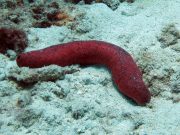
Holothuria edulis @ Koh Rok
The Pinkfish Sea Cucumber has a reddish-pink cylindrical body with rounded ends. There is sometimes a black area on the back/upper body, however this species can also be other colours, such as grey or dark brown.
The lower body has rows of small tube feet which help with movement, and which can be retracted into the body if necessary.
There are around 20 oral tentacles which can help with feeding, movement and also righting itself if it is overturned.
The Pinkfish Sea Cucumber grows to 35 cm and is found over sand and rubble is shallow areas of coral reefs.
Blue Sea Cucumber
(Actinopyga caerulea)
The Blue Sea Cucumber has a loaf-shaped body with some tapering toward each end. The body colour is mostly bluish, with white patches. The bluish areas are covered with small conical 'papillae', which are absent in the white areas.
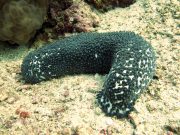
Actinopyga caerulea @ Koh Haa
The mouth of a Blue Sea Cucumber is on the bottom, surrounded by 15 to 18 large bluish-grey tentacles, which in turn are surrounded by a collar of bluish papillae.
The anus of the Blue Sea Cucumber is at the rear end, surrounded by 5 white anal teeth.
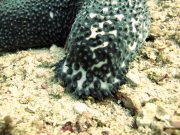
Actinopyga caerulea @ Koh Haa
Unlike many other members of the family Holothuriidae, the Cuvierian organ is absent in Blue Sea Cucumbers and this species is unable to eject Cuvieran tubules if stressed.
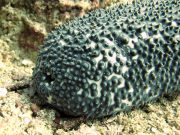
Actinopyga caerulea @ Koh Haa
Diving with Holothuriidae Sea Cucumbers around Koh Lanta
Scuba Diving & Snorkel Trips
If you'd love a chance to spot Holothuriidae Sea Cucumbers on one of our daily high season diving trips from Koh Lanta then send us an email to info@diveandrelax.com.
Join our high season speedboat dive trips to some of Thailand's best dive sites and enjoy small groups, short journey times, with a focus on great personal service, safety and fun.
Not yet a certified diver? Learn to Scuba Dive on Koh Lanta with the 3 day SSI Open Water Diver course.
Book online to save 10% on dive trips and scuba courses on Koh Lanta.
Find Out More
Indo-Pacific Marine Life Guides
- Allen, G., Steene, R., Humann, P., DeLoach, N. (2003) Reef Fish Identification, Tropical Pacific. Jacksonville, FL., USA: New World Publications, Inc., ISBN 1-878348-36-1.
- Humann, P., DeLoach, N., (2010) Reef Creature Identification, Tropical Pacific. Jacksonville, FL., USA: New World Publications Inc., ISBN 978-1-878348-44-9
- Debelius, H. (2013) Indian Ocean Reef Guide. Frankfurt, Germany: IKAN - Unterwasserarchiv, ISBN 978-3-939767-52-7.
- Debelius, H. (2004) Nudibranchs and Sea Snails, Indo-Pacific Field Guide. Frankfurt, Germany: IKAN - Unterwasserarchiv, ISBN 3-925919-51-1
- Erhardt, H., Knop, D. (2015) Corals Indo-Pacific Field Guide. Frankfurt, Germany: IKAN - Unterwasserarchiv, ISBN 3-925919-69-4.
- Veron J.E.N., Stafford-Smith M.G., Turak E. and DeVantier L.M. (2016). Corals of the World


